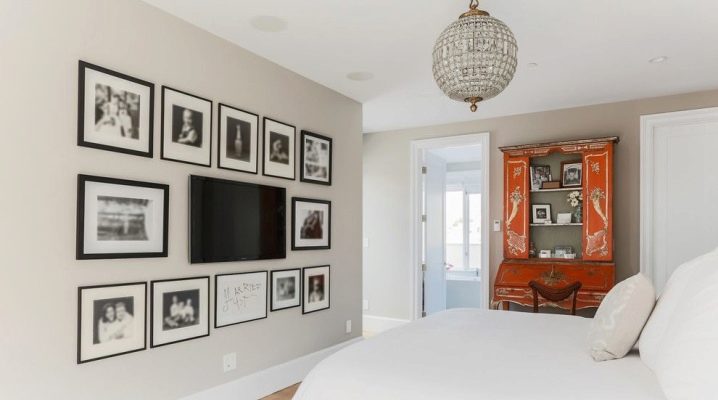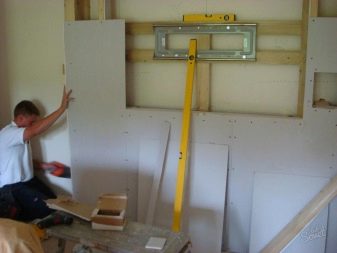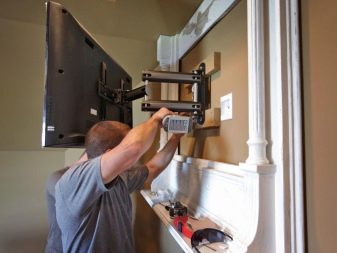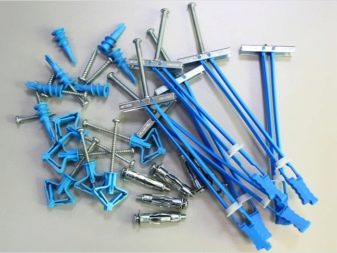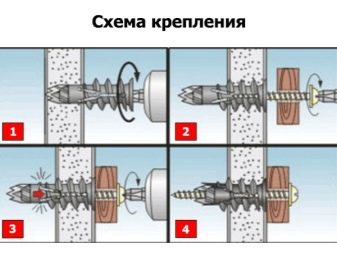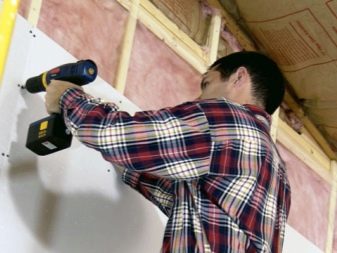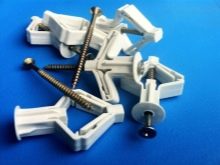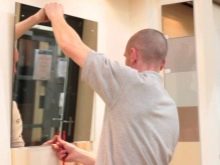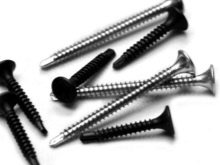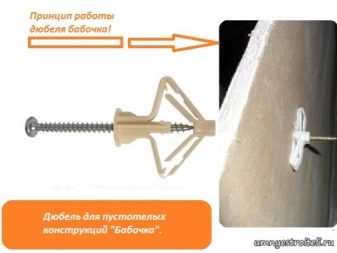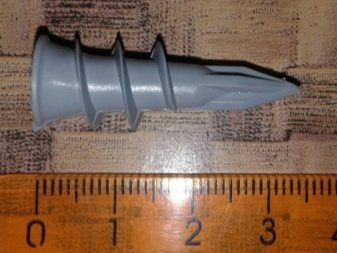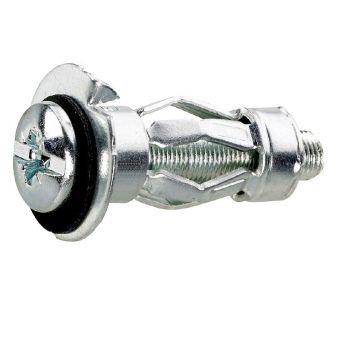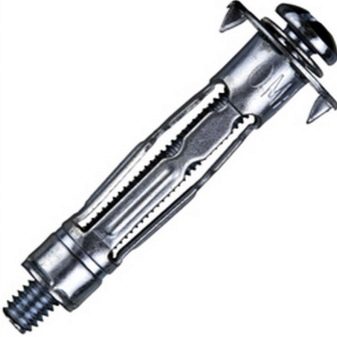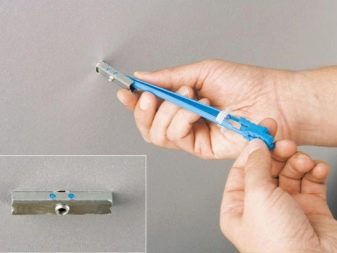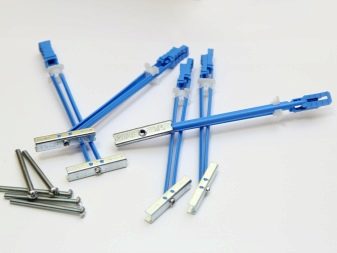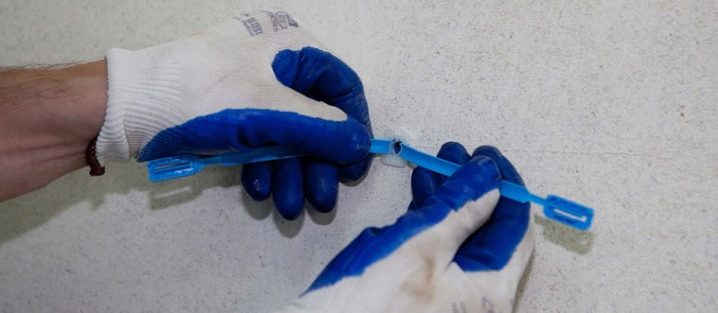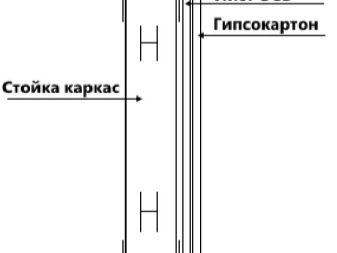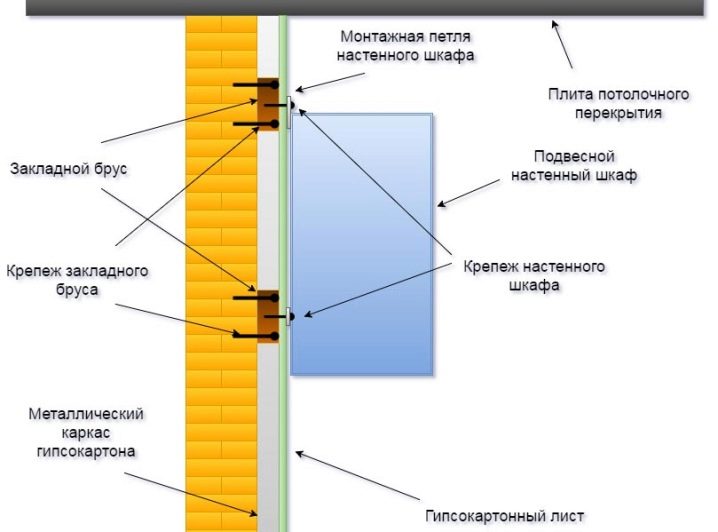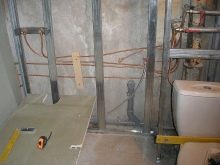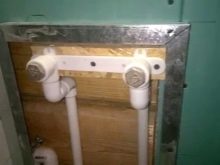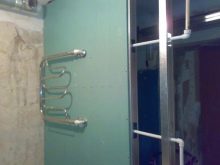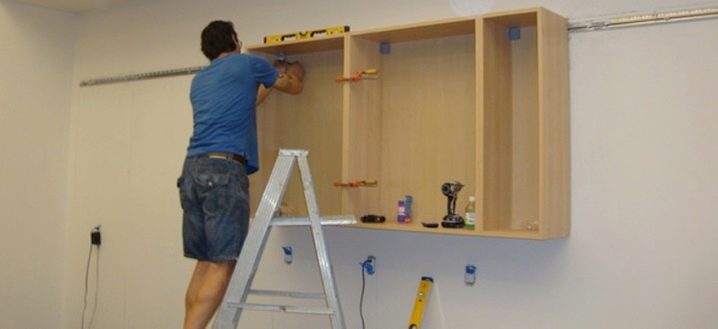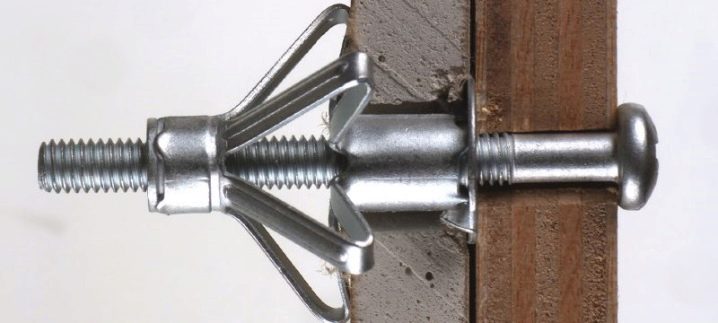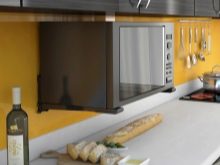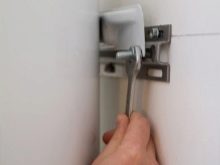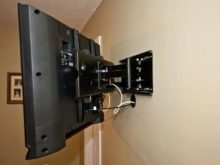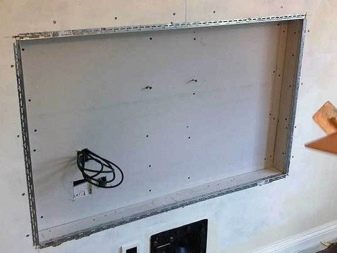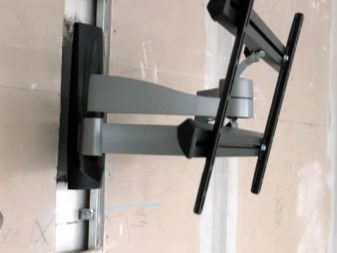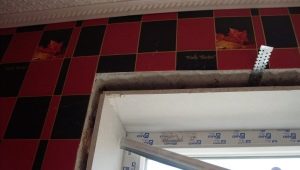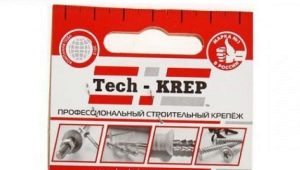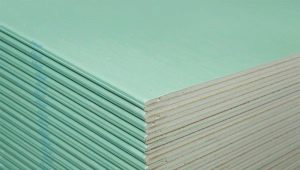How to hang items on the drywall wall?
In construction and repair work often used drywall. It allows you to get beautiful smooth walls without any plastering, to create any decorative elements, to produce high-quality ceiling finish.
GKL irreplaceable when making arches and creating different shapes. The material has an affordable cost and ease of installation, but it has some technical features. One of them is associated with fastening heavy objects.
Special features
Of course, you can hang a not too heavy shelf on the plasterboard wall by drilling the sheets through. Dowel free full length enters the hole directly in the wall. Then the screws are twisted, and the shelf rests on them.
However, fixing a large mass on a sheet of such material is not so easy. Traditional methods do not work here.For example, on a wall lined with plasterboard with a thickness of up to 12 mm, it is very difficult to fix a heating radiator, a dishwasher or other heavy device. Fasteners can simply break out of the skin. If you try to hang on a wall of shelves trimmed with drywall, they can fall along with all the contents and partly with plating.
Plasterboard wall capable of withstanding a weight of up to 55 kg on each mount, but at the same time they must be correctly selected. Twisting screws into the design is not enough, you have to use dowels.
It should be noted that they can not be used many times, because when re-tightening the fastening reliability is markedly reduced.
How to fix?
The problem of attaching heavy objects to drywall can be solved in one of several ways.
They are:
- installation under the installed object of the corresponding supports and fasteners;
- pre-installation under the lining of the walls of the mortgages;
- combined mortgages with mounting hardware.
If repairs are not planned in the near future, then dismantling the wall is not the best option.You can mount items through fasteners without using mortgages. The main thing is to choose exactly the hardware that will cope with the expected loads.
In such cases, used fasteners in the form of:
- metal-metal self-tapping screws for gypsum plasterboards;
- dowel "butterfly" with screws;
- screw dowels with screws;
- dowel type "umbrella" with bolts;
- Dowels Harmut Knauf with bolts.
To strengthen the sheets on the profiles are used conventional self-tapping screws that can hold a load within 3 kg. This means that you can hang something like a mirror, a clock or a picture on such a screw, fix the baseboards. Increased strength is achieved by hanging on several loops.
Increases durability and dowel "butterfly". If the wall is sheathed with a single layer of material, this mount will withstand a weight of up to 10 kg. With it, you can attach to the drywall a small shelf or lamp. As in the previous case, the stability of fasteners increases when using several spaced dowels.
The fastener consists of nylon, has edges for rigid fixation.This prevents cranking, and when screwing in the screw the design opens in two directions, like butterfly wings. They run into the lining from the inside, distribute the load and hold the chandelier or other object.
Fasteners made of nylon, equipped with a screw-type thread, called "driva". It twists the same nozzle and can withstand a load in the range of 25-30 kg. This allows you to secure the eaves with curtains.
The dowel Molly allows you to attach to the wall of plasterboard even kitchen cabinets of large masses. It is a metal hardware with a screw, having side slots. It is installed with special tongs. In drywall, you need to make a hole corresponding to the dowel in diameter, and then insert the mount, bending the wings and tucking the screw.
Screw type fastening in combination with a screw does not require a hole in the wall. The fastener holds approximately 6 kg on the skin in one layer and up to 15 kg in two layers.. This option is suitable for portraits and baguettes.
An umbrella-type dowel is a variation of a metal butterfly. It includes a block and strut, which opens like an umbrella when tightening.
If the hardware is installed correctly, the load on each of the fasteners can be up to 35 kg, and with a larger number of them, the weight of the items can be increased. So hangers and not too heavy pieces of furniture.
Due to the dowel Harmut from Knauf, it is possible to mount cabinets, drawers or other items weighing up to 35 kg on a single-layer skin. The greater the number of hardware, the higher the permissible degree of load.
Installing the dowel requires drilling a hole with a diameter of 13 mm, insert dowels with assembled spacer, pulling fasteners back. The expansion structure is sewn to the gypsum from the inside. Next, the plastic part is fixed to the outside with a clamp, the excess is broken off. Then the bolt is screwed in, fixing the hanging loops or hardware.
This method is suitable for fairly heavy things, such as a sink or cabinet. But constructions weighing more than 100 kg are attached exclusively to the walls, sheathed in two or three layers.
The diameter of the fastener must be selected taking into account the weight of the items for which it will be used. Due to well-chosen dowels, it is possible to ensure a strong connection with the plasterboard wall of virtually any elements of furniture and decor. To calculate the attachment, you need to add the thickness of the gypsum board to the distance to the wall, and then add the same figure to provide a fixation margin.. Dots are laid out on the wall surface, drilling through them. The drill on concrete at the same time has to go deep into the wall for the calculated distance.
How to make mortgages?
If you have to fix heavy objects weighing over 50 kg (boiler, water heater, etc.) on drywall, you can do it with mortgages. In this case, the installation is carried out not to the FCL, but to the draft wall, on which the mortgages are fixed. Here you will need a puncher, as well as a dowel, screws or dowel-nails. For foam or aerated concrete blocks, the fastening of bars is performed on metal “crocodiles”. Ordinary dowels will not hold in a fragile material, especially under load.
Thus, mortgages must be put under the skin, i.e. it must be done before plasterboard. If the dimensions of the bookmarks do not fully fit the hinges on the item being installed, you can use the combined method.
Mortgage installation includes several steps:
- After assembling the frame, select the place where you plan to install the item.
- Cut the bars along the thickness of the guides between the profiles.
- Secure them with dowel-nails or anchor bolts to the profiles or wall.
- Sideways connect the bars with the profile with screws.
- Sew a drywall frame.
When the wall decoration is complete, fix the cabinet, kitchen sets, or any other large mass objects with screws. Even the horizontal bar will hold tight in such bars.
In order to get equipment not into empty space, but into bars, it is better to photograph them during the installation. They usually have a size of 40x50 mm or 70x40 mm, depending on the metal frame.
Bars should not be too thin so that drywall is not pressed through. Also, too thin bars can lead to unnecessary bulges.
Having predetermined the location of the object, you can correctly place the mortgages. The bars are mounted so that each side is inserted into the profile. This makes it possible to increase the rigidity of the structure. The ends of the profiles can be extended if necessary, and subsequently they can be fastened with screws. Mortgage fasten dowels "butterfly", sunk into the board of the screw heads.You can use the anchor with a countersunk head.
It is impossible to hang heavy equipment by screwing long screws into a wall without mortgages. In this case, an excessive load on the fasteners is created. Over time, this can lead to deformation of the mounts or the wall itself.
Mounting accessories in the bathroom
Particularly noteworthy is the installation of equipment in the bathroom. Fixing the mixer here is not as easy as on brick or concrete. The water outlet helps to simplify the process. For reliable fastening of a fitting in a hollow wall establish traverses (special plates with holes). Structurally, they may vary, so you have to find the best option for attaching a water outlet. This approach allows you to firmly fix the design, outputting pipes for a heated towel rail or faucet.
Performing the markup for the sink and taps, It should be borne in mind that the horizontal level of cranes must exceed the height of the sides of the sink by 20-25 cm. The tap that supplies water to the toilet bowl is placed at a height of 80 cm, for a shower screen, at least at a height of 210 cm.
Heated towel rails are attached to the gypsum wall by reinforcing profiles. This requires a preliminary markup. Due to the screw, twisted in profile, the equipment will be fixed on the wall and will not create an unnecessary load on the casing.
Tips and tricks
The use of profiles is a good option for fixing decorative shelves and other elements to drywall.
Such works are performed in a specific order:
- On the surface of the skin is determined by the location of the metal profile. It is convenient to use a magnet for this.
- GKL is stitched through with metal screws. A self-tapping screw is used that is 5-6 cm longer than the sheet itself.
- With the help of a screwdriver, the object is attached to the surface of the wall, the screws pass through.
This method is used to fix objects of small mass, but not serious equipment. Kitchen cabinets usually have eyelets at the top. If these mounts do not coincide with the profile, Eyelet can be removed and rearranged to a more suitable place.. Since drywall does not belong to the carrier materials, you can make holes larger than the diameter of the screw.
Wall panels are often trimmed with decorative film to give an attractive look and texture. In this regard, the screws in the drywall need to be screwed up after the final finishing of the panel. Due to the fastening on the frame, the strength of the joints is ensured, and the plasterboard creates an even and beautiful wall.
If drywall is mounted on a special glue with a minimum distance from the wall (or the skin is made on a frame close to the wall), for fixing the necessary things you can use anchor screws. To do this, markup is applied, holes are made on it and an anchor is hammered. Screws are fixed in the wall due to tightening.
Here it is important to pierce a hole of exactly that diameter that the anchor itself has.. It will not enter a small hole, but a backlash will appear in a large hole, and strong fixation will not work.
If the drywall is located at a considerable distance from the wall or is fully mounted on the frame, this option will not work due to the heavy load. For such situations apply dowels or brackets.
Fastening with hooks and brackets is one of the easiest ways to install not-too-heavy items of heavy weight. It is enough to buy such devices and fix them with screws on the wall. To increase the strength of fasteners it can be performed to the frame stand. Due to the large area of the bracket, the load is distributed, and the screws are firmly fixed in the material.
Another method of attaching very massive cabinets or other elements to a concrete wall with a plasterboard lining is to remove part of the drywall. This allows you to access directly to the wall in which the hole is drilled.
There the dowel is inserted, the screw is twisted to the maximum fixing strength. The drywall sawn piece is subsequently put in place and fixed with a putty. The second option is to level the entire hole with the same putty.
On how to properly hang items on drywall, see below.
